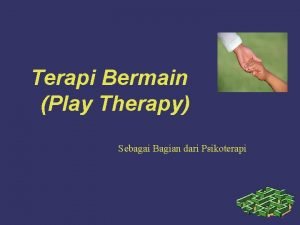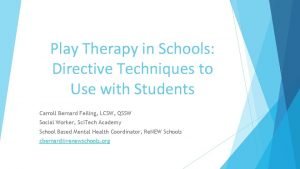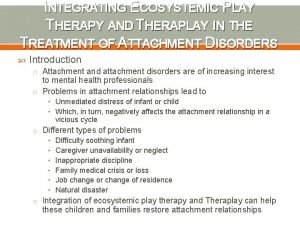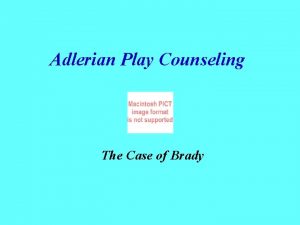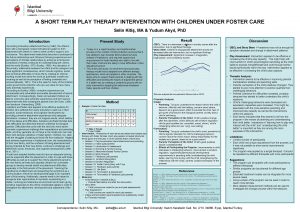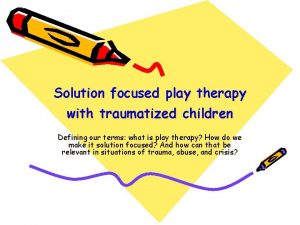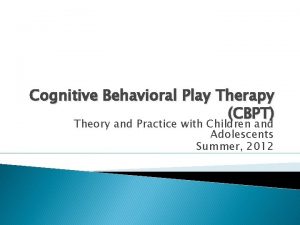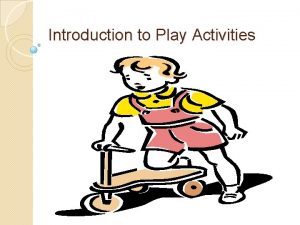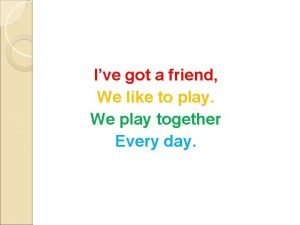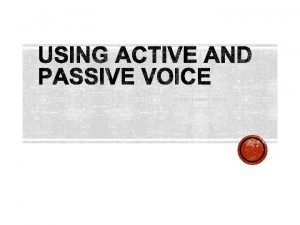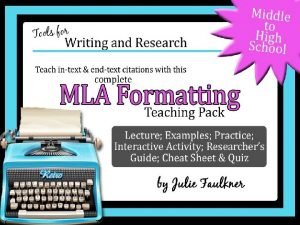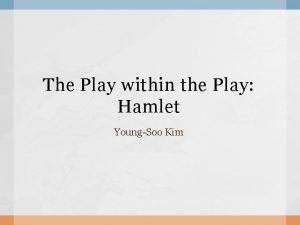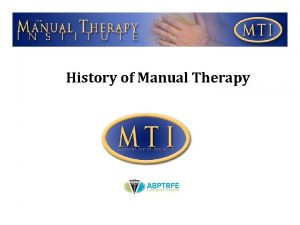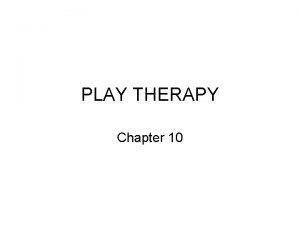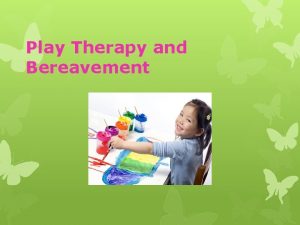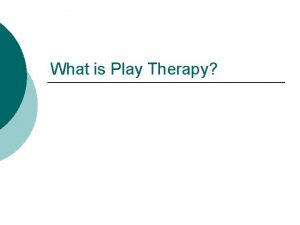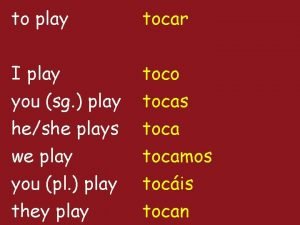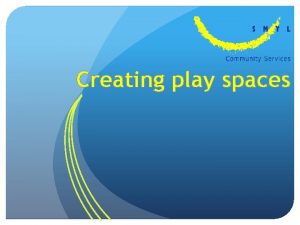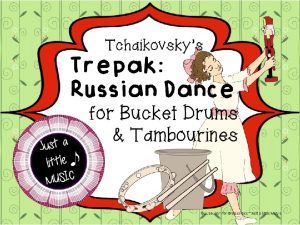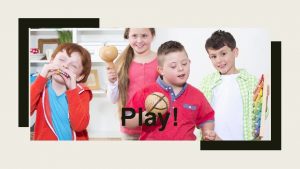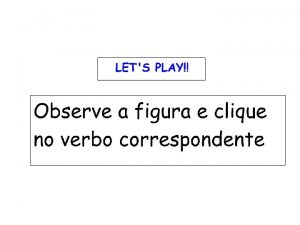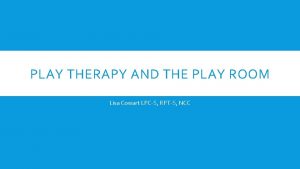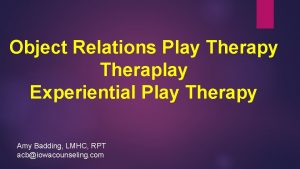Chapter 4 Play Therapy History of Play Therapy

















- Slides: 17

Chapter 4 Play Therapy

History of Play Therapy • Roots in psychoanalysis • Basic Tenet: Unconscious Conflict Brought to conscious awareness resolves symptoms • Interpretation of play is curative, creates conscious awareness of unconscious material • Psychoanalysts were primarily nondirective, free play in child = free association for adults • Adlerians, Jungians, and CBT psychotherapists have employed play therapy • Common Toys: Sand Tray, Family dolls, Food, Bottles, Doll House

Psychodynamic Play Therapy • Object Relations Theory: Child’s play is doorway to their unconscious 1. Integrate personality structure – to promote development/maturity (e. g. , manage puberty, separation/individuation, reduce reactive rage or narcissism) 2. Soften a harsh superego: reduce selfcriticism/anxiety 3. Reducing Envy

Object Relations Theory: Process of “Differentiation” • Autism: 0 -2 mos: undif, detached, prim narcis • Symbiosis: 2 -6 mos: “holding”, merger, omnipt • Separation-Individuation: 6 -24 mos – Hatching Subphase: 6 -10 mos: mother is sep, transitional object, stranger anx – Practicing Subphase: 10 -16 mos: narcis, omnipt hi – Rapprochement Subphase: 16 -24 mos: Splitting; vulnerable, bad/good mother; mood swings ØDeveloping Object Constancy: 24 -36+mos Ø Depressive dis; mother is good and bad

Psychodynamic Play Therapy – Melanie Klein Theory: Interpretation of themes of envy, rage, abandonment in play • Include importance of trust, rapport with Therapist – Donald Winnicott’s Approach • Importance of the “holding environment” (nurturing mother caring for infant) in play therapy • Therapist transference as the “good enough mother” • Play is where we are “real” selves, essential child/adult • Squiggle Drawing: Class Demo in Dyad + Story telling

Mutual Story Telling: Richard Gardner • Method to draw out child’s needs, concerns • Gives insight into the child’s conflict • Method: Therapist begins a story open ended “Once upon a time there was a ______ This _____lived in _______ with ________loved to________ and so one day…. . ”

Cognitive Behavior Play Therapy • Directive Play Therapy: Goal Directed, Child given direction and instruction – Teaching, Shaping, Reinforcing wanted Behaviors – Exp: Teaching to inhibit behaviors through board games that demand turn taking, frustration tolerance in managing losing, modeling good sportsmanship – Application: ADHD, Modulate Aggressiveness, Promote Socialization – Case Example: Playing Uno with a child who is depressed, withdrawn, low positive social experiences. Use as medium of rapport and positive reinforcement (praise).

CBT Playroom • Board Games: Sorry, Trouble, Connect Four, Checkers, Tokens, Charts for self-monitoring – Therapist performs all the moves while discussing strategy out loud. • Therapist models turn taking, problem-solving, decision making, and strategies to win. • Therapist helps encourage child to “Stop, Think, Choose” • Therapist will give child tokens for goal behaviors/ Principle of Shaping

CBT Play Therapy • Systematic Desensitization: gradual habituation to feared stimuli (treat phobias, avoidance anxiety) – Imaginary: use toys to emulate feared objects or situation (sleeping in the dark, monsters at night) – Graduated exposure using visualization then en vivo, low to high subjective units of distress

Rogerian Child-Centered Play Therapy Virginia Axline “ There seems to be a powerful force within each individual which strives continuously for complete selfrealization. This force may be characterized as a drive towards maturity, independence, and self-direction…but it needs a good growing ground” • Pathology occurs when experiences are denied, distorted, ignored, or unintegrated • In the absence of distortions, experiences are integrated into the self-structure

Necessary & Sufficient Conditions for Growth and Change Warm friendly rapport with therapist Client experiences congruence Accept child as he/she is Therapist allows feeling of permissiveness to promote free expression • Therapist experiences empathic understanding for client, reflects child’s thoughts and feelings • Child experiences counselor’s Unconditional Positive Regard and empathy • • • Therapist does not hurry or direct therapy, trusts child will self -direct

Play and Development • Intrinsic value: healthy for cog/physical dev • Means of finding mastery over difficult emotional realities • Provides children with a way to express internal experiences • Provides children with a way to symbolize earlier experiences, thus building a foundation for continued development

CCPT with Young Children and Adolescents • Young children (< 3 years of age) – Work with Parent and Child in session – Primary focus is on children’s attachment to caregivers • Adolescents – Same principles apply to provide symbolic language to internal conflict – acknowledge the adolescent’s increasing understanding of emotions and the social environment

Attachment Family Therapy • Directions to Parents: (first modeled by therapist) – Set up 30 min of play, consistent time weekly – No Directions or limit setting unless destructive behaviors – Apply Nondirective Principles in Play • • • P: Praise R: Reflection I: Imitate D: Describe E: Enthusiasm

Attachment Play Therapy • The consistency, responsiveness, and congruency intended to mimic essential infantile needs – Build Trust – Secure Attachment – Communication – Reduce Anxiety – Improve self-esteem

Play History Questions • Adjunct to Initial Assessment – – – – – What is the child’s favorite toy/game? How long does the child play with one toy? Is your child responsible for keeping his toys in order? Does your child collect anything? Can your child finish a game? Tolerate losing? How much tv/computer time? What does child do on the computer? Video Games? Does your child like to draw? Does your child play cooperatively with other? What role? What sports does your child play/enjoy?

View Sand Play • You tube video: “Sand” – example of its use in Play Therapy • • What is therapist’s role? How directive is the play? Can directive therapy be incorporated? Can Story-Telling/Narrative Therapy be integrated?
 Psychodynamic and humanistic therapies have in common
Psychodynamic and humanistic therapies have in common Bioness integrated therapy system price
Bioness integrated therapy system price Humanistic therapies aim to boost
Humanistic therapies aim to boost Contoh play therapy
Contoh play therapy Play therapy examples
Play therapy examples Ecosystemic play therapy
Ecosystemic play therapy Objectives of play therapy
Objectives of play therapy Alderian play therapy
Alderian play therapy Floortime play therapy
Floortime play therapy Short-term play therapy for children
Short-term play therapy for children Solution focused play therapy
Solution focused play therapy Cbpt
Cbpt Play activities meaning
Play activities meaning I've got a friend we like to play we play together
I've got a friend we like to play we play together Louise made the chocolate cake active or passive
Louise made the chocolate cake active or passive Play by play
Play by play Hamlet kim
Hamlet kim James cyriax manual therapy
James cyriax manual therapy



